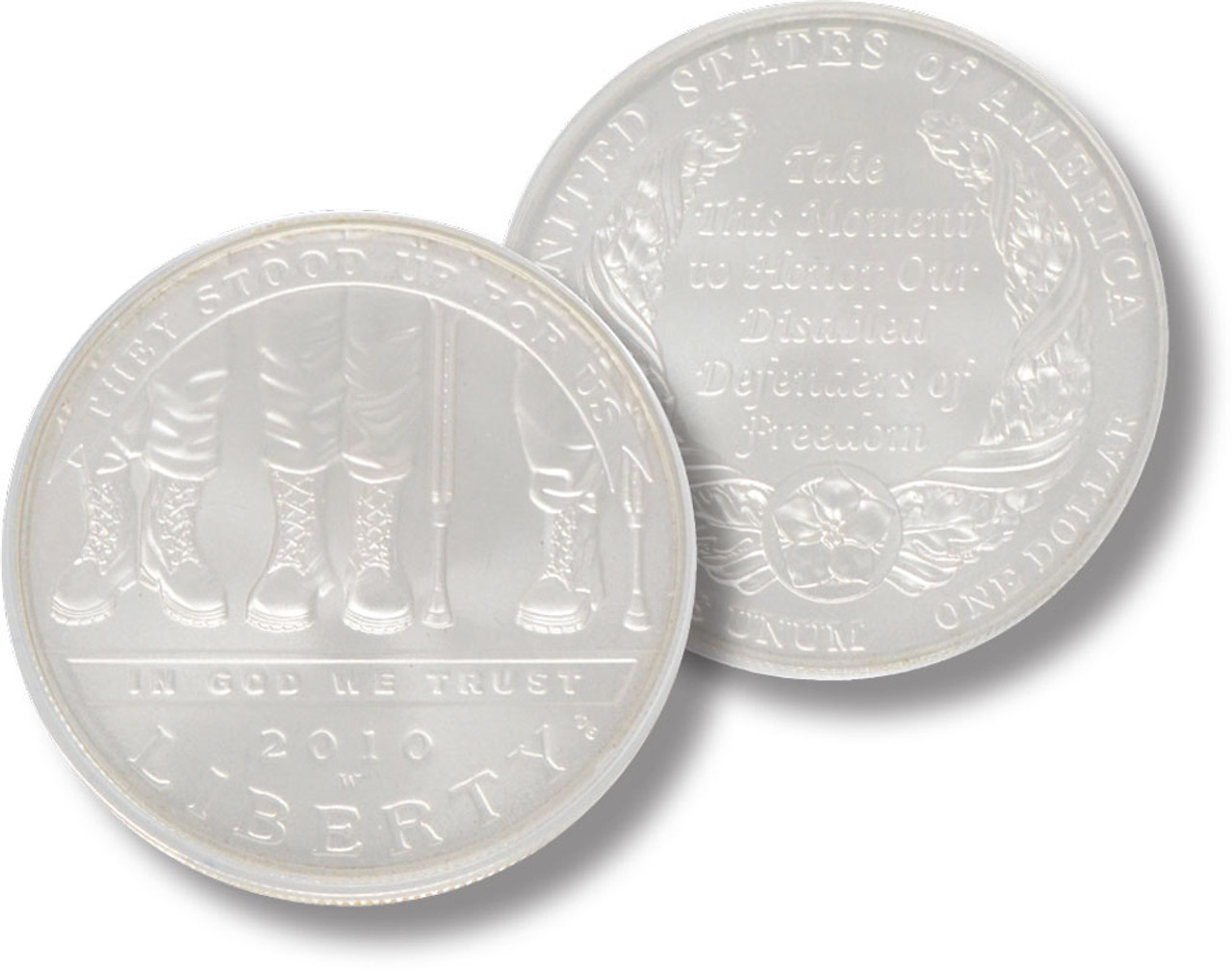
Own a U.S. Mint Silver Dollar
Honoring Disabled American Veterans
Minted in 2010, this uncirculated US Silver Dollar coin pays tribute to America’s disabled veterans. The front pictures the legs and boots of three veterans with a banner reading, “They stood up for us.” The back says “Take This Moment to Honor Our Disabled Defenders of Freedom” and is ... more
Own a U.S. Mint Silver Dollar
Honoring Disabled American Veterans
Minted in 2010, this uncirculated US Silver Dollar coin pays tribute to America’s disabled veterans. The front pictures the legs and boots of three veterans with a banner reading, “They stood up for us.” The back says “Take This Moment to Honor Our Disabled Defenders of Freedom” and is surrounded by oak branches and a forget-me-not flower. The forget-me-not has been a symbol of the fallen since World War I. A portion of the proceeds from this coin were given to the Disabled Veterans’ LIFE Memorial Foundation to help fund the construction of the American Veterans Disabled for Life Memorial in Washington, DC. This coin is a meaningful tribute to our veterans and it belongs in your collection.
Minted: 2010
Diameter: 1.5”
Composition: 90% silver, 10% copper
Number Minted: 350,000 of all varieties
History of the Disabled American Veterans
Returning home after World War I, many disabled veterans were at a major disadvantage and received little governmental help. Many were blind, deaf, or mentally affected from their service. Some 204,000 American soldiers had been wounded in the war. Across the country, small groups of disabled veterans formed as social clubs or to raise money for those that couldn’t support themselves.
Then on Christmas Day in 1919, Cincinnati Superior Court Judge Robert Marx, a captain who had been injured in the war, hosted a party. The party was for a group of about 100 disabled veterans who were spending the holidays away from home, recovering from their war wounds. That night, Marx was inspired to create a national organization to help support the thousands of disabled veterans. Before the party ended, he and some of his fellow veterans began planning a meeting to gauge interest and establish goals.
By early 1920, Marx had helped to found the Disabled American Veterans of the World War (DAVWW). By spring, Marx was holding regular meetings in his office and had drafted articles of confederation. He then began contacting other similar groups around the country and arranged for a national caucus in Cincinnati on September 25, 1920. At that caucus, the group formed the national DAVWW and established state-level departments and local chapters.
Shortly after, Marx was invited on a nationwide presidential campaign tour for Ohio Governor James Cox. While Marx was invited along because he was a war hero who lent his support to Cox, he used the trip to meet with representatives from other clubs in 32 states and build up the DAVWW network. He also encouraged them to come to group’s first national convention the following June.
That convention convened on June 27, 1921 in Detroit. Over 1,000 disabled veterans attended and voted Marx to serve as their first National Commander. They also formed a permanent organization, constitution, dues, selected headquarters, and planned for the next convention. The convention received national attention, with letters arriving from President Warren G. Harding, Vice President Calvin Coolidge, and General John A. Pershing. They also staged a parade through the streets, gaining the group significant public support. By the end of that convention, they had 17,486 members.
The first major goal of the DAVWW was pressing Congress to create a single government agency to oversee their programs. At the time, there were three different programs and they were poorly coordinated. They achieved success in 1930 with the creation of the Veterans Administration.
For the second national convention in 1922, Henry Ford organized a cross-country trip of 50 Model Ts to help several veterans attend the meeting. That convention would see the creation of the DAVWW Auxiliary, intended to help the families of disabled veterans.
In 1932, the DAVWW received a federal charter from Congress. During World War II, they began producing their IdentoTags, miniature license plates. Each year, they would mail out millions of these tags to American drivers to attach to their key chains. Then if the keys were found, they could be mailed o the DAVWW, who would then in turn return them to the owner. This helped raise millions of dollars for the DAVWW over the next several decades. It was also during World War II that they changed their name to the Disabled American Veterans. The DAV would continue to support veterans through the wars of the next century. Today, they have nearly 1.3 million members, providing millions of dollars in support to our disabled veterans.












